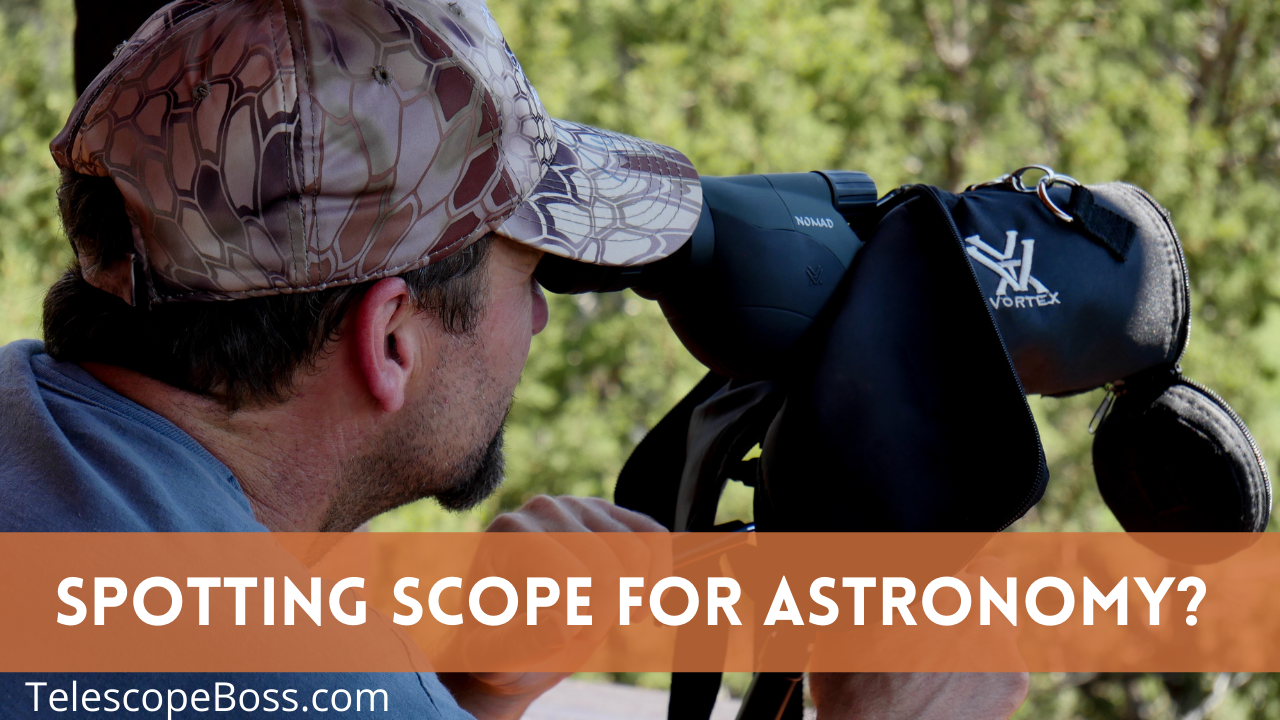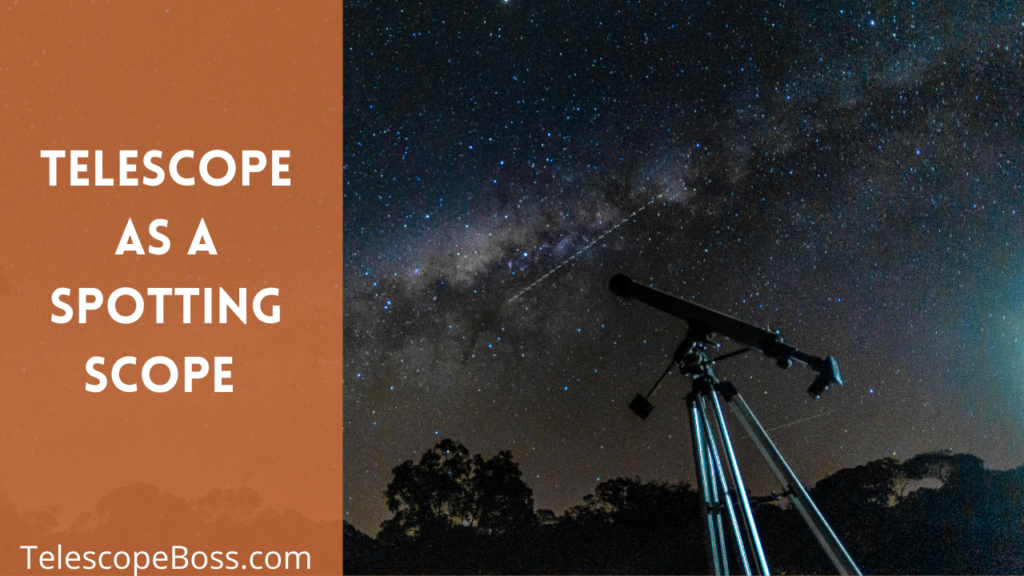Spotting scopes are designed to be used when viewing things on Earth, but they are a low cost way to see some objects in the night sky as well.
Spotting scopes can be used as telescopes, but they are not as versatile as telescopes for astronomy. The quality of your image will depend on the spotting scope and the weather conditions when observing. They are not designed for use as a telescope so they are awkward to look through for long periods of time.
Spotting scopes can be used to get into the hobby and if you have one, take it out and give it a try, but if you are shopping for your first scope go with a telescope. Your money will go further in the hobby with a low cost telescope.
Cost
Spotting scopes are often more expensive than telescopes with comparable optics. I recommend that beginners start with an 8 inch Dobsonian reflector telescope which will cost around $700. Spotting scopes can be had for between $40 and $1,000 or more.
Design
Spotting scopes are designed to be used to look at things on Earth so it might be
Features
Spotting scopes do offer some interesting features for astronomy, many are waterproof. This makes them great for stargazing when backpacking. They can take a lot more knocks than a telescope.
Some spotting scopes have dual focus allowing you to use higher magnification and still get a crisp image.
Some spotting scopes allow you to use various eyepieces making them more versatile for astronomy. Eyepieces come in two sizes, 2” and 1.25” and for a spotting scope only the 1.25” size will fit in a spotting scope. Be careful when purchasing eyepieces.
How much magnification can I get with a spotting scope?
Most spotting scopes have magnification between 20 and 60x with some getting as high as 75x. Some spotting scopes allow for the use of other eyepieces that can increase the magnification as well.
A pair of binoculars are usually about 10x magnification, but a telescope can have magnification up to 200x or more.
It is possible to add eyepieces to a spotting scope on some models. These eyepieces can increase the magnification of your spotting scope. Pentax is one brand of spotting scope known to accept eyepieces.
Magnification is important, but it is not the most important specification for astronomy. When observing at night aperture is very important because it determines how much light can enter your scope. Spotting scopes are designed to be used in low light conditions, but not complete darkness. Spotting scopes are designed for terrestrial viewing where there is much more light than in space.
One way that spotting scopes are different is that the image in a spotting scope is corrected to look the same as if you were looking with your eyes. The image in most telescopes is upside down and mirrored. Telescopes make this choice to preserve as much light as possible so
astronomers can see faint far away objects. So, naturally, spotting scopes do not do as well with very dim objects.
You can use a spotting scope to see brighter objects like planets, the moon, double stars and other brighter night sky targets. The more light the more magnification can be used.
Should I buy a spotting scope for astronomy?
A spotting scope is convenient for observing, it is lightweight, rugged and generally waterproof, but they are not designed for astronomy. A telescope is a much better purchase for observing planets and stars. If you are traveling or backpacking and want a lightweight way to observe in a dark area a spotting scope will give you greater magnification and aperture than a pair of binoculars.
Spotting scopes are also very simple. They do not require eyepieces and they are easy to transport and set up.
Buy a telescope if you are looking to start out with astronomy, but if you already own a spotting scope, it can be used and will give you a good introduction to the hobby.

Can you use a spotting scope to see the moon?
Spotting scopes are best for observing bright objects in the sky and the moon is a good target for a spotting scope. The biggest hindrance will be finding a comfortable position to observe in.
A spotting scope will allow you to see the geography of the moon in greater detail. It is even possible to see Jupeter and some of its moons with a spotting scope. If you have a spotting scope it is well worth bringing it out at night to see what you can see.
Spotting scopes can be straight or angled at 45 degrees. They are designed to be used on a tripod very close to the ground. This is difficult if you are trying to view objects above the horizon.
Can you see Mars with a spotting scope?
Mars is the third brightest object in the night sky and it can be observed with a spotting scope. Use an app like Star Safari to locate the planet. Planets look very similar to stars through a telescope, it will not twinkle like a star, but give a steady light.
The planet will appear very small.
Observing open clusters of stars will be much more interesting to observe with a spotting scope. Spotting scopes have a very wide field of view, so looking at something large like double clusters of stars and galaxies are going to be more impressive.
Can you see the rings of Saturn with a spotting scope?
Spotting scopes magnify with 20-60 power and that will allow you to see the rings of Saturn in good conditions. This is such an exciting sight for a new astronomer. Check an app like ClearSkies to check the weather conditions like cloud cover and seeing conditions for the best views.
Be sure to share this amazing site with friends and kids. Many people always remember the first time they see the rings of Saturn.
It is important to note that you cannot see the rings of Saturn with a pair of binoculars that only provides 10x magnification.
Can you use a telescope as a spotting scope?
Telescopes are more versatile than spotting scopes. Telescopes with the correct eyepiece, a correcting diagonal and a small tripod can make a good spotting scope.
It is much easier to use a telescope as a spotting scope in terms of optics, you will be able to see as far or further with a telescope.
Spotting scopes are designed to be lightweight and portable and they are designed to be used in daytime.
Telescopes will be much heavier, require more setup and be more difficult to transport in many cases.
Some telescopes are more suited to use as a spotting scope, a smaller refractor will have a similarly wide field of view to a spotting scope.






